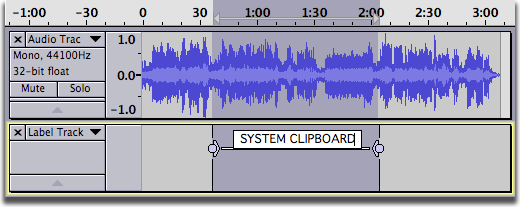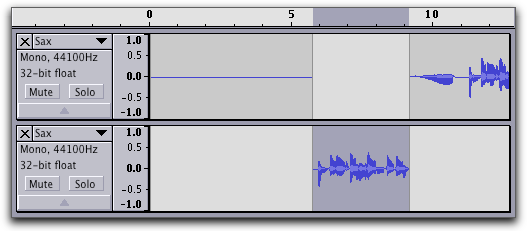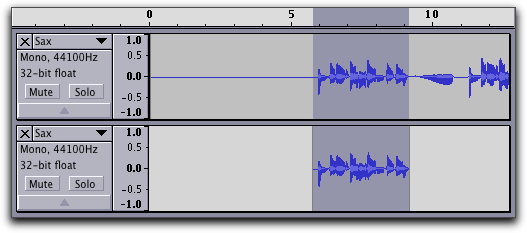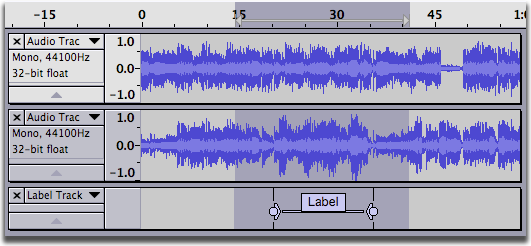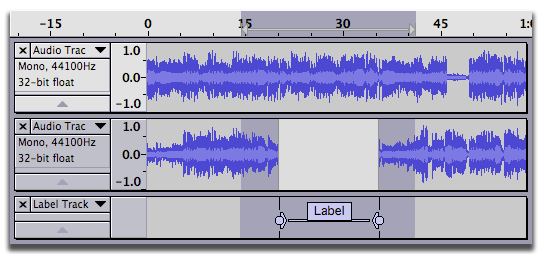Edit Menu
From Audacity Manual
Undo
This will undo the last editing operation you performed to your project. You can undo as many times as you want, all the way back to when you opened the window. To undo many operations, select History... from the View Menu.
Redo
This will redo any editing operations that were just undone. After you perform a new editing operation, you can no longer redo the operations that were undone.
Cut
Removes the selected audio data and places it on the clipboard. Any audio to the right of the selection is shifted to the left. Only one "thing" can be on the clipboard at a time, but it may contain multiple tracks and clips.
Split Cut
Same as Cut, but none of the audio data to the right of the selection is shifted. This leaves a gap and also splits the existing audio clip into two clips that can be moved independently using the Time Shift Tool.
Copy
Copies the selected audio data to the clipboard without removing it from the project.
Paste
Inserts whatever is on the clipboard at the position of the selection cursor in the project, replacing whatever audio data is currently selected, if any.
When you select Paste and the cursor is inside a clip, pasting is allowed only if "Editing clips can move other clips" is checked. The audio gets inserted into the middle of the clip and the following audio is shifted to the right to make room.
When you select Paste and the cursor is outside a clip, and there is enough room for the audio that is on the clipboard, the audio on the clipboard can be inserted without any other clips being shifted over if "Editing clips can move other clips" is not checked. If "Editing clips can move other clips" is checked, the following audio will always be moved.
Paste Text to New Label
Pastes the text on the clipboard at the cursor position in the currently selected label track. If there is no selection in the label track a point label is created. If a range is selected in the label track a range label is created.
The most recent text cut or copied to the clipboard is pasted. If you have copied or cut a label to the clipboard, the text of that label will be pasted. If you have cut or copied text to the clipboard from an application other than Audacity, that text will be pasted.
If no label track is selected one is created, and a new label is created.
In the example below, the text "SYSTEM CLIPBOARD" was copied from a word processing document, then the "Paste Text to New Label" command was executed.
Trim
Removes all audio from the current clip except the selected part, creating its own clip from the remaining audio. Does not affect or move other clips in the same track (note the audio in the clip to right is unaffected).
Delete
Removes the audio data that is currently selected without copying it to the clipboard.
Split Delete
Removes the selected audio without placing it on the clipboard, but does not shift the following audio. The preceding and following audio are now separate clips that can be moved independently.
Silence Audio
Replaces the selection with silence
Split
Splits the current clip into up to three clips at the selection boundaries. The audio before, within, and after the selection can now all be shifted independently
Split New
Does a Split Cut on the current selection in the current track, then creates a new track and pastes the selection into the new track.
Join
If you select an area that overlaps one or more clips, they are all joined into one large clip. Regions in-between clips become silence.
Disjoin
In a selection area that includes absolute silences, creates individual non-silent clips between the regions of silence. The silence becomes blank space between the clips.
Duplicate
Creates a new track containing only the current selection as a new clip
Labeled Regions...
A labeled region is a region in an audio track that is spanned by a label. The labeled region commands are available when a selection exists in a label track that spans one or more labels.
The Labeled Region commands apply the following commands to any labeled regions in the current selection area.
Cut, Split Cut, Copy
Delete, Split Delete, Silence Audio
Split, Join, Disjoin
The selection shown above was created by dragging in the label track then shift-clicking in the second audio track. Applying the command results in this:
Note that audio has been cut only in the region spanned by the label. If linking had been on (not available in 2.0) the label would have been cut as well.
Select
The items in this cascading menu provide quick ways of selecting ranges of audio.
All
Selects all of the audio in all of the tracks.
None
Deselects all of the audio in all of the tracks.
Left at Playback Position
Select this command while Audacity is playing or recording to set the left edge of the selection.
Right at Playback Position
Select this command while Audacity is playing or recording to set the right edge of the selection.
Track Start to Cursor
Selects a region in the selected track(s) from the start of the track to the cursor position.
Cursor to Track End
Selects a region in the selected track(s) from the cursor position to the end of the track.
Find Zero Crossings
Moves the edges of a selection region (or the cursor position) slightly so they are at a rising zero crossing point. This is a point where a line joining the audio samples rises from left to right and crosses the zero horizontal line. Cutting and pasting at a zero crossing helps avoid clicks by matching the height of the waveform at the join. Note: this feature does not necessarily find the nearest zero crossing to the current position. It aims to find the crossing where the average amplitude of samples in the vicinity is lowest.
Move Cursor
The items in this cascading menu provide quick ways to move the cursor.
To Selection Start
Changes the right edge of the selection to equal the left edge.
To Selection End
Changes the left edge of the selection to equal the right edge.
To Track Start
Moves the cursor to the start of the selected track
To Track End
Moves the cursor to the end of the selected trackRegion Save
Saves the current selection region and its position on the Timeline. Note this function does not save any actual audio data currently inside the selection boundaries.
Region Restore
Restores the selection region to the project at its saved Timeline position. The restored region is only explicitly placed inside those tracks which are currently selected.
Play Region
The items in this sub-menu allow you to lock and unlock the play region in the Timeline. See Play Regions in Playing and Recording.
Preferences...
Displays the Preferences dialog.








